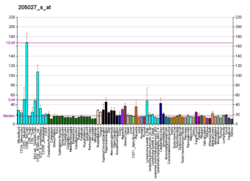Function
The gene was identified by its oncogenic transforming activity in cells. The encoded protein is a member of the serine/threonine-specific protein kinase family. This kinase can activate ERK1, ERK2 and p38 MAP kinases. [8] [9] This kinase was shown to activate IkappaB kinases, and thus induce the nuclear production of NF-kappaB. This kinase was also found to promote the production of TNF-alpha and IL-2 during T lymphocyte activation. Studies of a similar gene in rat suggested the direct involvement of this kinase in the proteolysis of NF-kappaB1, p105 (NFKB1). This gene may also start transcription at a downstream in-frame translation start codon, and thus produce an isoform containing a shorter N-terminus. The shorter isoform has been shown to display weaker transforming activity. [7] In mice, the gene is known as TPL2 and is a tumor-suppressor gene whose absence contributes to the development and progression of cancer. [10] However, it functions in other organs as a oncogene, promoting cancer. [11]
This page is based on this
Wikipedia article Text is available under the
CC BY-SA 4.0 license; additional terms may apply.
Images, videos and audio are available under their respective licenses.




